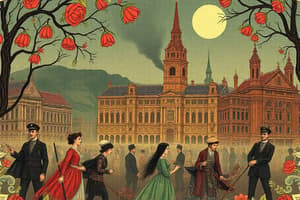Podcast
Questions and Answers
Which countries were part of the Allied coalition during World War II?
Which countries were part of the Allied coalition during World War II?
- Britain, United States, India (correct)
- Britain, France, Russia
- Germany, Italy, Japan
- China, South Africa, Japan
What significant event contributed to the outbreak of World War II?
What significant event contributed to the outbreak of World War II?
- Treaty of Versailles
- Bombing of Hiroshima
- Battle of Stalingrad
- Invasion of Poland by Nazi Germany (correct)
Which technological advancements emerged during World War II?
Which technological advancements emerged during World War II?
- Invention of the internet
- Introduction of smartphones
- Widespread deployment of airpower and tanks (correct)
- Discovery of penicillin
What did the Nazis construct to exterminate millions of Jewish people and other groups during World War II?
What did the Nazis construct to exterminate millions of Jewish people and other groups during World War II?
How did the lessons learned from World War I and World War II impact international relations?
How did the lessons learned from World War I and World War II impact international relations?
What were the main alliances involved in World War I?
What were the main alliances involved in World War I?
Which event is commonly considered the trigger for World War I?
Which event is commonly considered the trigger for World War I?
What major shift in warfare was synonymous with World War I?
What major shift in warfare was synonymous with World War I?
How long did World War II last?
How long did World War II last?
Which of the following nations was NOT part of the Central Powers in World War I?
Which of the following nations was NOT part of the Central Powers in World War I?
Flashcards are hidden until you start studying
Study Notes
A Brief Overview of Global Conflicts: World War I and II
In the span of less than five decades, humanity witnessed two of history's most devastating conflicts: World War I and World War II. These wars shaped our modern world by reshaping borders, fueling advancements in technology and politics, and altering global power dynamics.
World War I
Known colloquially as the Great War, it occurred between July 1914 and November 1918. It involved multiple alliances—the Triple Entente of Britain, France, and Russia against the Central Powers consisting of Germany, Austria-Hungary, Bulgaria, and Ottoman Turkey.
This conflict was sparked by numerous factors: imperial competition over colonies; nationalist fervor among subject peoples; militarism and arms races; alliance systems; and escalating crises like the assassination of Archduke Franz Ferdinand of Austria-Hungary.
World War I resulted in more deaths, approximately nine million from combatant countries alone, and created a cultural shift in how societies viewed warfare and its consequences. Trench warfare became synonymous with this era, as opposing armies dug deep into the earth rather than engaging in open battlefields.
World War II
The second global conflict began just 21 years after the conclusion of WWI, spreading across Europe, Asia, Africa, and the Pacific Ocean, and lasted until September 1945. This time, there were clear divisions: an Allied coalition composed primarily of Britain, the United States, Canada, Australia, New Zealand, India, South Africa, and China versus the Axis powers that included Germany, Italy, and Japan.
While several events contributed to the outbreak of World War II, notably the invasion of Poland by Nazi Germany in 1939, historians also point to interwar diplomacy, territorial ambitions, and economic circumstances as significant causes.
During World War II, some key aspects emerged. Among these were the widespread deployment of airpower and tanks; the advent of nuclear weapons, which changed the course of conflict irrevocably; concentration camps constructed by the Nazis to exterminate millions of Jewish people and other groups deemed undesirable.
By the end of both conflicts, major changes had taken place globally as new nations came into existence, old ones disappeared, and political ideologies evolved. The lessons learned from these struggles have helped shape the course of international relations ever since their conclusion.
Studying That Suits You
Use AI to generate personalized quizzes and flashcards to suit your learning preferences.




